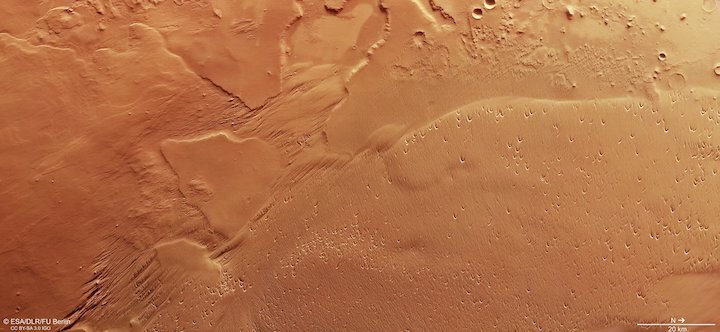25.02.2022

The Medusae Fossae Formation on Mars. (Image credit: ESA/DLR/FU Berlin, CC BY-SA 3.0 IGO)
An enormous dust deposit on Mars shows the power of Martian wind in a new image snapped from orbit.
Standing on the surface of Mars is possibly the largest single dust source on the Red Planet: the Medusae Fossae Formation (MFF). Shaped and sculpted by blowing winds over time, this mound of dust and surface material stretches out over 3,100 miles (5,000 kilometers) and lies nestled between Tharsis and Elysium, the planet's most prominent volcanic areas.
In a new image, the European Space Agency's Mars Express orbiter captured the Medusae Fossae Formation in all its dusty, windy glory.
The Medusae Fossae Formation (MFF) is named for Medusa, the Gorgon from Greek mythology who could turn anyone to stone with just eye contact. But looking at this wind-carved dust deposit won't turn you to stone (we promise).
From orbit, the MFF looks almost like an Earthly desert. But the unique marks, grooves (known as yardangs) and shapes that make up the vast feature are the work of Martian winds.
The feature is mostly smooth in appearance. But, as you can see in the lower right side of the image, the MFF's surface is speckled with small, crescent-shaped depressions.
Scientists think that the dust and material that comprise the MFF is likely volcanic ash from the volcanoes in Tharsis nearby, according to ESA. It's thought that ash from these volcanoes was deposited through wind or what scientists call "pyroclastic flows" — fast-moving streams of lava, gas and rocky material. The Tharsis region includes Olympus Mons, the largest volcano in the solar system, among other volcanoes.
The MFF is not the only Martian feature shaped by the wind on Mars. Others include Nili Fossae, Arabia Terra, Syrtis Major, Mars' southern dunes and Schiaparelli Crater.
Quelle: SC
